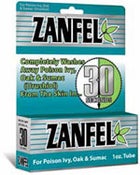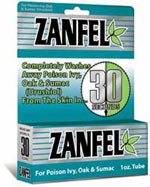Put it this way: After you’ve become entangled with this stuff, $40 for a one-ounce remedy to combat urushiolthe active ingredient in poison oak and poison ivymay seem cheap indeed.

As I’ve written here before, poison oak is one of the most insidious plants out there. Once the urushiol resin gets onto your clothing, boots, or poles, it can stay there for months. Worse still, its resins literally bind to human protein, causing a vicious allergic reaction and weeping rash that can completely debilitate some people. Treatments are mediocre at bestcortisone creams seem to helpand there are also skin creams that repel the urushiol. These are called Ivy Block and StokoGard Outdoor Cream. Both form a barrier over your skin that the urushiol can’t penetrate.
Zanfel, on the other hand, is supposed to remove the urushiol from your skin cells, which sounds pretty good bearing in mind that ordinary soap won’t do much goodthe urushiol is chemically a little like pine pitch, so soap just bounces off. I’ve not had firsthand experience with Zanfel, but user reviews are decidedly mixed. The consensus seems to be that it is moderately effective, but on balance barely worth the very high price.
Obviously, your best policy is avoidance. But, it wouldn’t hurt to try a bottle of Zanfel. If it doesn’t work, don’t buy any more. If does, well, make your own decision. And of course, don’t do any deliberate experiments, such as rubbing poison oak on yourself and then trying the Zanfel! That’d just be stupid now, wouldn’t it.


